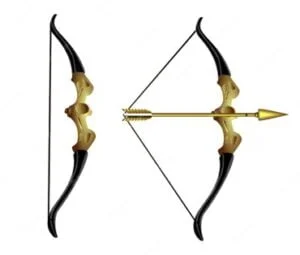This topic is covered in Physics honors, AP Physics 1 and AP Physics C Mechanics.
- Have you ever wondered how a toy car with a wound-up spring can move forward without any external energy source?
- How a bow and arrow can launch an arrow forward with incredible speed and accuracy?
These everyday objects and devices are powered by mechanical energy, which is a fundamental concept in physics that underlies many aspects of our daily lives.
In this blog, we will explore the following concepts:-
- Introduction: Understanding the concept of mechanical energy conservation
- Types of Mechanical Energy: Kinetic and Potential Energy
- Law of Conservation of Mechanical Energy: Explanation and Formula
- Real-life Examples: How Mechanical Energy Conservation Works
- Elastic Potential Energy: Definition and Examples
- Work and Energy: Relationship between Mechanical Energy and Work
- How to Calculate Mechanical Energy Conservation in Different Scenarios
- Energy Transformation: Interconversion of Mechanical Energy to Other Forms of Energy
- Limitations and Challenges of Mechanical Energy Conservation
- Conclusion: The Significance of Mechanical Energy Conservation in Our Lives
By the end of this blog, you will have a deeper understanding of this fundamental concept in physics and how it applies to the physical world around us. So let’s explore the exciting world of mechanical energy and discover how it powers many of the objects and devices that we rely on every day!
What is Work in Physics?
In our daily life, if we are sweating or tired, then we say that it means we have done some work.
But in Physics, if we are applying force on an object which causes its displacement in such a way that its direction of motion is not perpendicular to the direction of the force exerted by us upon it, we will say that we have done some work on it.
It means if you are applying a high amount of force on a wall but are unable to move a single brick, I am sorry, but you have done no work. It doesn’t matter how much you sweat or are tired (unless you break the wall).
If you apply force on a particle of mass m so that it covers the displacement d at an angle
![]()
with the direction of a force
![]()
applied by you, the work done by you on the particle will be-
![]()
Or
![]()
If the force applied by you on the object is not constant and varies as a function of the displacement of the particle, the total work done by you will be equal to the sum of all works due to their respective forces. In that case, the total work will be –
![]()
Here
![]()
is the force applied as a function of the displacement of the particle and
![]()
is its small displacement due to small constant force, i and f represent the initial and final configuration of the particle.
Type of Energies: Kinetic and Potential Energy
Kinetic Energy
Any object which is in motion, whether it is projectile, rectilinear, circular, rotational, periodic or any kind of motion, the object will be called more energetic than a similar object at rest.
This energy of a moving object due to its motion is called its kinetic energy. It means the kinetic energy will be zero for an object at rest.
If a particle of mass m is moving with speed v then its kinetic energy k can be written as:
![]()
Similarly, if an object is made of n similar particles of mass m and this object is moving with the speed v then its kinetic energy will be-
![]()
Note:- Each elementary particle will move here with the speed v.
Potential Energy
In this blog, we will study two types of potential Energy
1) Gravitational potential energy
2) Elastic potential energy
Gravitational Potential Energy
Suppose you throw a football upwards (as shown in the cover illustration), and it starts moving upwards with some speed just after losing contact with your palm.
But due to gravity, it decelerates & its speed (and hence kinetic energy) decreases.
Since we know that the energy can neither be created nor be destroyed so, where did this lost kinetic energy vanish?
Actually, this lost kinetic energy is stored in the football in another form of energy which is called potential energy. As the football moves up, its kinetic energy decreases and its potential energy (stored energy) increases.
If we assume that the potential energy of the object at an instant when it was about to just lose contact with the palm was zero, then the football’s velocity becomes zero for an instant when it reaches its peak and at that instant, its kinetic energy is zero.
It means the entire kinetic energy is converted into the potential energy. Then the ball starts to accelerate downwards and its kinetic energy increases.
At the time of its fall, the energy stored in the football starts to convert into kinetic energy. As the football falls down, its potential energy decreases and kinetic energy increases.
In this way, we can say that potential energy is a form of energy stored to be used later.
Since the kinetic energy is changing due to the presence of gravitational force, it means this force on the football is responsible for bringing the potential energy in the picture. That’s why this type of potential energy is called gravitational potential energy of the football.
Elastic Potential Energy
Similar thing happens due to the spring. Consider a spring suspended vertically whose one end is pivoted at the ceiling, and some weight is suspended with another end of the spring (see the GIF illustration).

Initially, when there was no weight on the spring, the
Spring was in its normal (or natural) length. When we suspend a weight on its bottom, it expands and the weight moves downward due to gravity with some kinetic energy.
But as the spring elongates vertically,the kinetic energy of the weight decreases. Kinetic energy becomes zero (when maximum elongation of the spring takes place).
Now we can ask the same question again: where does this kinetic energy vanish?
And the answer is again that this kinetic energy is stored in the spring in another form of energy which is called potential energy.
Since the potential energy is stored in the spring this time and it comes into existence due to the spring force, hence it has a different name that is elastic potential energy.
Note:- Elastic potential energy is introduced not only due to spring but it can also be introduced due to the deformation of other materials such as rubber bands & colliding balls etc.
Type of forces
In this blog, we will study about four types of forces:
1) Conservative forces
2) Non-conservative forces
3) Internal forces
4) External forces
Conservative forces:
This force conserves energy, and there is no dissipation of mechanical energy due to these forces.
The work done by these forces does not depend upon the path of the object upon which the work is to be done, it depends only on the initial and final configuration of the object.
Gravitational force, electric force and spring force are some examples of conservative forces.
Non-conservative forces:
This type of force causes the loss of mechanical energy of a system. The work done by these types of forces does not depend upon the initial and final state of the object but depends upon the path of the object.
Friction , air resistance and viscous forces are some examples of non-conservative forces.
Internal forces:
When the elements of a system exert forces on each other then these forces are called internal forces of the system.
In the GIF illustration of spring and weight shown above,the spring and gravity apply spring force and gravitational force respectively, on the weight so these forces are called internal forces.
External Forces:
When there is a force applied on the elements of a system by an object other than the elements of the system, it will be called external force.
For example, the air is not included in the system so the force exerted by the air (that is, air resistance)will be called external force applied on the weight suspended by the spring.
Relation between Work and Energies:
Relation between Work and Kinetic Energy:
You know that the kinetic energy of a particle of mass m moving with speed v will be-
![]()
Now differentiate both sides with respect to the time. Then we will get-
![]()
It is important to note that the direction of
![]()
is along the velocity of the particle so
![]()
which implies
![]()
If the force applied on particle has the direction at an angle
![]()
with the direction of displacement of particles then
![]()
which implies
![]()
From equation (i) and (v) we can write,
![]()
Or
![]()
Where
![]()
and
![]()
are the final and initial kinetic energy of the particle. It means that the work done on a particle is equal to the change in its kinetic energy due to the applied force which causes its displacement.
This statement is called the work-energy theorem.
Relation between Work & Potential Energy:
If the initial (when the work is just starting to be done on the object) and final(when the work is completely done) potential energy of an object are
![]()
and
![]()
respectively then
![]()
Now you may ask a simple question: how did I know?
So let’s prove it through a statement.
You know that when you just throw a ball upwards, you give it some kinetic energy. We assume that there is no potential energy stored in the football at this instant then the potential energy at the highest level reached by football will be maximum while kinetic energy of the football at this instant will be zero.
Now you should notice that final potential energy is equal to initial kinetic energy here and vice versa(because there are no non-conservative forces). It means
![]()
and
![]()
From the work-energy theorem, we know that
![]()
From equation (vi) and (vii), we can write that
![]()
Now from equation (vi),(vii) and (viii), we can write
![]()
which implies
![]()
Note: Here it is assumed that any loss in kinetic energy would be completely converted into potential energy, which is true only if there is no non-conservative force (such as friction and air resistance) hence the relation between work and change in potential energy, as shown above, is valid only if there are only conservative forces and no work is done by non-conservative force .
Since this work is done by internal forces, this relation is valid only if the work is done by internal conservative forces.
Mechanical Energy and Its Conservation:
The sum of the Kinetic and potential energy of an object is called the total mechanical energy of the object.
From equation (ix) it is proved that;
“The total mechanical energy of an object remains constant if the internal forces applied on the object are conservative and no work is done by an external force”
This statement is called the law of conservation of mechanical energy.
It should be noted that the work-energy theorem is still valid in external and nonconservative forces.
For example, if you throw a stone upwards from the moonland and then apply same force on the same stone from the Earth land upwards,the work done in both of the cases will be same but the height reached by the stone will be more in the first case due to the absence of air resistance which is a non-conservative force.
If
![]()
and
![]()
denotes the conservative, non-conservative and external forces respectively working on an object ,from the work-energy theorem-
![]()
Where ∆k is the change the kinetic energy of the object.
Since
![]()
![]()
If the net work done by non-conservative forces is zero then
![]()
which implies
![]()
Where
![]()
and
![]()
are the final and initial mechanical energy of the object.
Hence the work done by the external force changes the mechanical energy of the object and violates the law of conservation of mechanical energy.
Real-Life Examples
1) Wound-up toys: The conservation of mechanical energy can be applied to toys, such as a toy car with a wound-up spring or a wind-up toy plane. When the spring is wound up or the plane is pulled back, potential energy is stored in the system.

As the spring or plane is released, the potential energy is converted into kinetic energy, causing the toy to move forward. The total mechanical energy of the system remains constant, with the potential energy being converted into kinetic energy.
2.) Bow and Arrow: When the bowstring is pulled back, potential energy is stored in the system, with the energy being stored in the bow as elastic potential energy. When the bowstring is released, the potential energy is converted into kinetic energy, propelling the arrow forward.

The total mechanical energy of the system remains constant throughout the process, with the potential energy being converted into kinetic energy.
Conclusion:
Mechanical energy conservation is a fundamental concept in physics that underlies many everyday objects and devices. It is based on the principle that the total mechanical energy of a closed system remains constant and can be used to calculate the energy transformations that occur in a variety of scenarios.
Despite its many benefits, mechanical energy conservation has some limitations and challenges, including the fact that energy conversions are not always perfectly efficient, some forms of energy are difficult to convert into mechanical energy, and the laws of physics place constraints on the types of energy transformations that are possible.
Overall, mechanical energy conservation is an important concept in physics that has practical applications in many areas of science and engineering and is essential for understanding the behavior of the physical world around us.
Do you know that collisions and momentum questions find its application in Conservation of Energy? Read this blog Collisions and Momentum



